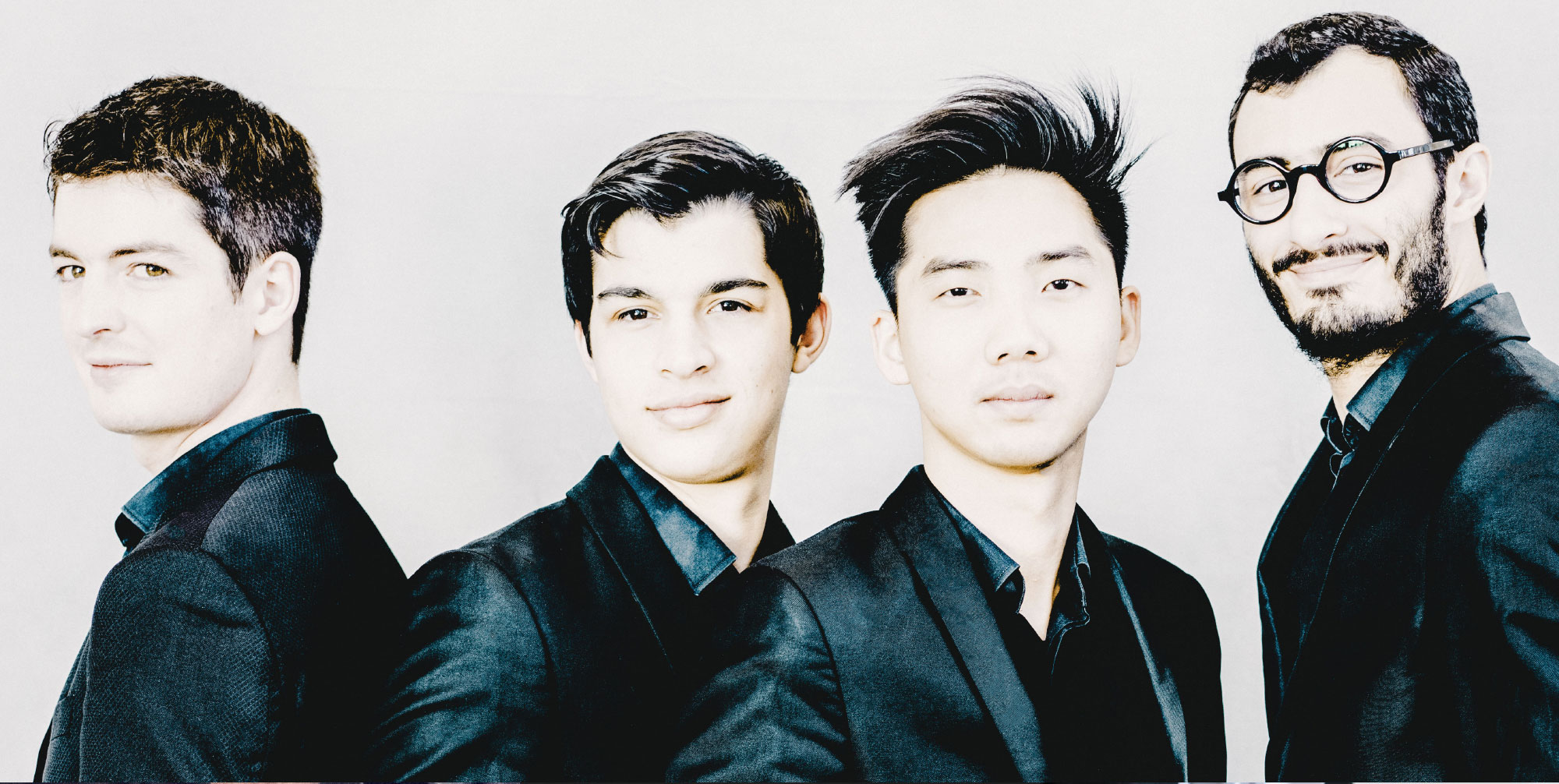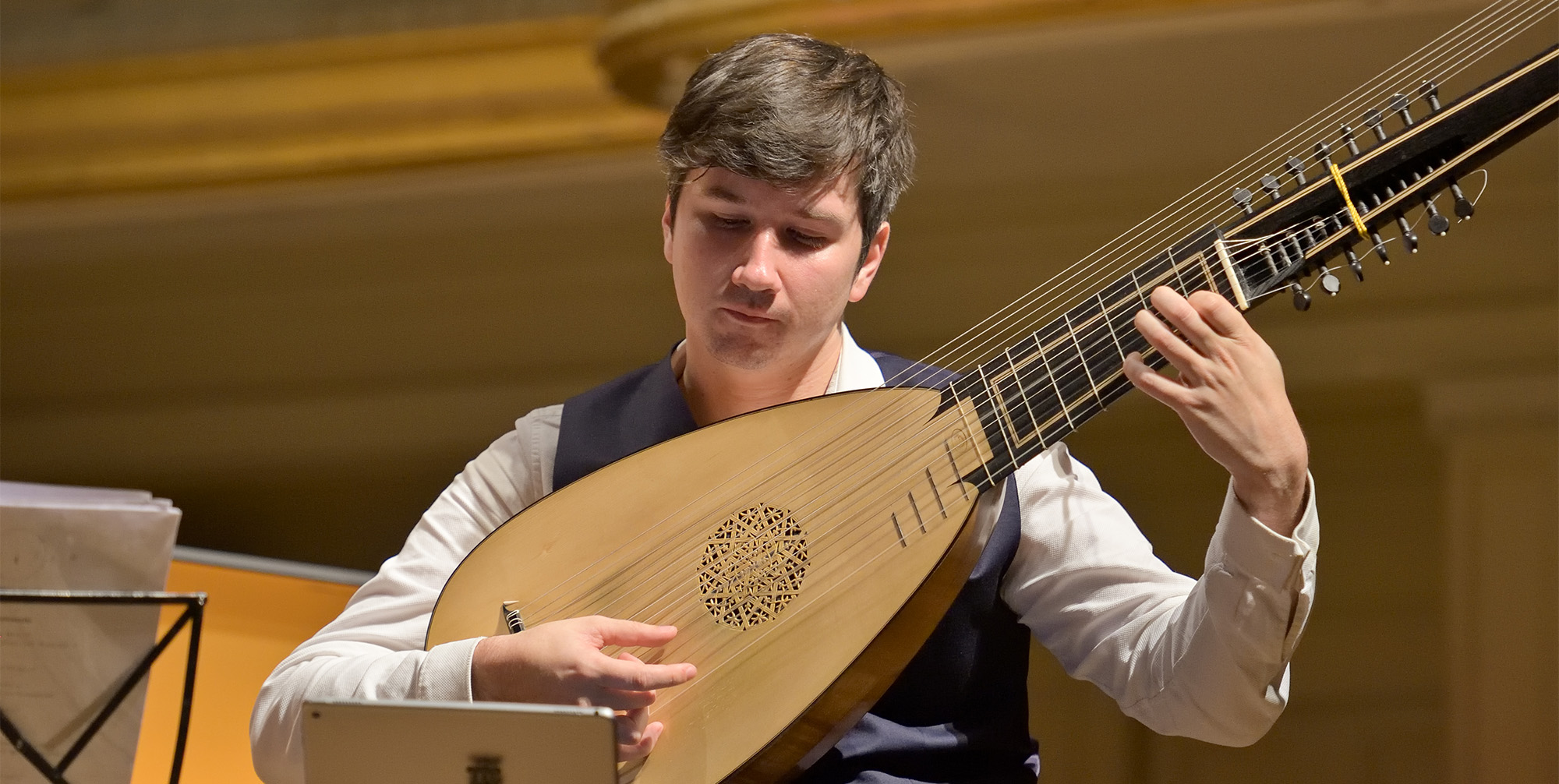
Wednesday
1 JUN 2022
7:45 pm – 9:15 pm
Salle de musique / avenue Léopold-Robert 27, La Chaux-de-Fonds
Jean Rondeau harpsichord Thomas Dunford luth
Dialogue on the rising and King’s bedtime
The reign of Louis XIV (from 1661 to 1715) was particularly rich artistically. A great lover of art in general, and music in particular, the king sang, played the guitar and had a strong taste for dancing. Music was omnipresent at court and accompanied both exceptional moments and daily rituals. From the Great Rising to Supper and Bedtime, the rigorous ceremonial that punctuated the monarch’s life gave rise to pieces by major players in the musical life of Louis XIV’s long reign.
Robert De Visée (circa 1650-1665 – after 1732) Suite in D minor (lute and harpsichord) Marin Marais (1656-1728) Les Voix humaines, Lentement (from the Suite No. 3, Second book of viola da gamba and luth) François Couperin (1668-1733) Premier Prélude en do majeur (from L’Art de toucher le clavecin) La Ménetou, Le Dodo ou l’amour au berceau, La Ténébreuse, La Favorite (lute and harpsichord) Jean-Henry D’Anglebert (1629-1691) Prélude (from the Suite in D minor, harpsichord) Sarabande Grave (lute and harpsichord) Antoine Forqueray (father, 1672-1745) Jean-Baptiste Antoine Forqueray (son, 1699-1745) La Portugaise La Sylva Jupiter (Lute and harpsichord)  At the beginning of the Baroque period, French composers of solo instrumental music created a language that would inspire many composers from the rest of Europe. In the 17th century, the lute found its home in France: while the first books of lute pieces contain primarily transcriptions of vocal works, later collections offer a totally instrumental repertoire. Virtuoso lutenists such as Denis Gaultier considerably developed the language of the lute: free polyphonic writing, complex ornaments and a broken style (the arpeggio). Little by little, the guitar came to the forefront of the scene (witness the paintings of Watteau, where courtiers and shepherds prefer the guitar to the lute). One musician was to arouse the court’s infatuation with this instrument, certainly less noble, but nevertheless simpler technically speaking: it was Robert de Visée, composer, multi-instrumentalist and guitar teacher to the king. Often required to instruct or sometimes entertain Monseigneur le Dauphin (the future Louis XV), Robert de Visée also stood at the monarch’s bedside in the evening to play the guitar. The work we will hear here is the Suite in D minor: it is a suite of dances in which the contrasts between each of the movements are explored with a unifying principle, the single key. At this time, dance dominated French music. Pour le musicien, la connoissance de l’art de la danse est d’un grand secours pour mieux connoître le vray mouvement de chaque pièce et conserver le mouvement de la mesure. Robert de Visée often took part in Mme de Maintenon’s sumptuous soirées, where his partners included Couperin, Rebel and Forqueray. Antoine Forqueray, an outstanding gambist, has composed numerous pieces for the viol. Considering himself to be the only one capable of interpreting them, he opposed their publication all his life. It was his son, Jean-Baptiste, also an excellent gambist, who published his father’s works for viola da gamba as well as these same pieces transcribed for the harpsichord (where he set about preserving the low tessitura proper to the viol). At that time, most of the works were works in movement: when a composer wrote a piece, he or other musicians transposed it and adapted it to different types of instrumentation. It is on the harpsichord that La Portugaise, La Sylva, La Jupiter will be performed: pieces characterized by great theatricality and formidable sound power. It can be stated that no one has surpassed Marais, only one man has equalled him, the famous Forqueray. By saying that one played like a god and the other like a devil, the monarch himself seems to have had fun orchestrating the rivalry between Marais and Forqueray. Marin Marais, an extremely talented and prolific composer and performer, brought the art of the viol to a very high level of perfection. Between 1686 and 1725, he published five volumes of viol pieces, from which Les Voix Humaines, a work of great sensuality, is extracted. As most composers of his time, Marais drew his inspiration from literary sources, more precisely theatrical sources (Molière and Racine) and was inspired by the language of lyrical tragedy, of which Jean-Baptiste Lully is the most illustrious representative (the inescapable Monsieur de Lully, who appears on most of the dedications of the works heard tonight). Gaultier’s musical legacy survives in harpsichord music. It is in Jacques Champion de Chambonnières that the French harpsichord school finds its first great representative: a harpsichordist at the French court, his influence is considerable, especially on Louis Couperin (François’ uncle) and Jean-Henri d’Anglebert (who took over as Ordinary of the Music of the King’s Chamber for the harpsichord). In 1689, the latter published his Pièces de clavecin, the only work in which he added transcriptions of works by Lully to the dance suites of his composition. In France, this book is the first printed work to include a table of ornaments indicating the manner in which they are to be performed. We will discover the Prelude in D minor and the Sarabande Grave. Nicknamed “le Grand” because of his exceptional mastery of the organ and undisputed master of the harpsichord, François Couperin succeeded Jean-Henri d’Anglebert as court organist and also held the position of organist at the Chapelle Royale. Known today notably for his moving Leçons de ténèbres, he published a reference treatise, L’art de toucher le clavecin, which instructs the performer on the beautiful Touch of the Harpsichord and the taste appropriate to this instrument. His mutinous, sensual pieces, with poetic and mischievous titles, are as many small portraits and landscapes, bringing Couperin closer to the fabulist La Fontaine or the painter Watteau. During this royal evening, Jean Rondeau and Thomas Dunford, two alchemists who are keen on experimentation, will revisit the subtle and sublime French baroque of this period rich in contrasts, where the music is at once refined, flamboyant, theatrical and poetic. The King is dead! Long live the music! Comment: Céline Hänni, Centre de culture ABC
At the beginning of the Baroque period, French composers of solo instrumental music created a language that would inspire many composers from the rest of Europe. In the 17th century, the lute found its home in France: while the first books of lute pieces contain primarily transcriptions of vocal works, later collections offer a totally instrumental repertoire. Virtuoso lutenists such as Denis Gaultier considerably developed the language of the lute: free polyphonic writing, complex ornaments and a broken style (the arpeggio). Little by little, the guitar came to the forefront of the scene (witness the paintings of Watteau, where courtiers and shepherds prefer the guitar to the lute). One musician was to arouse the court’s infatuation with this instrument, certainly less noble, but nevertheless simpler technically speaking: it was Robert de Visée, composer, multi-instrumentalist and guitar teacher to the king. Often required to instruct or sometimes entertain Monseigneur le Dauphin (the future Louis XV), Robert de Visée also stood at the monarch’s bedside in the evening to play the guitar. The work we will hear here is the Suite in D minor: it is a suite of dances in which the contrasts between each of the movements are explored with a unifying principle, the single key. At this time, dance dominated French music. Pour le musicien, la connoissance de l’art de la danse est d’un grand secours pour mieux connoître le vray mouvement de chaque pièce et conserver le mouvement de la mesure. Robert de Visée often took part in Mme de Maintenon’s sumptuous soirées, where his partners included Couperin, Rebel and Forqueray. Antoine Forqueray, an outstanding gambist, has composed numerous pieces for the viol. Considering himself to be the only one capable of interpreting them, he opposed their publication all his life. It was his son, Jean-Baptiste, also an excellent gambist, who published his father’s works for viola da gamba as well as these same pieces transcribed for the harpsichord (where he set about preserving the low tessitura proper to the viol). At that time, most of the works were works in movement: when a composer wrote a piece, he or other musicians transposed it and adapted it to different types of instrumentation. It is on the harpsichord that La Portugaise, La Sylva, La Jupiter will be performed: pieces characterized by great theatricality and formidable sound power. It can be stated that no one has surpassed Marais, only one man has equalled him, the famous Forqueray. By saying that one played like a god and the other like a devil, the monarch himself seems to have had fun orchestrating the rivalry between Marais and Forqueray. Marin Marais, an extremely talented and prolific composer and performer, brought the art of the viol to a very high level of perfection. Between 1686 and 1725, he published five volumes of viol pieces, from which Les Voix Humaines, a work of great sensuality, is extracted. As most composers of his time, Marais drew his inspiration from literary sources, more precisely theatrical sources (Molière and Racine) and was inspired by the language of lyrical tragedy, of which Jean-Baptiste Lully is the most illustrious representative (the inescapable Monsieur de Lully, who appears on most of the dedications of the works heard tonight). Gaultier’s musical legacy survives in harpsichord music. It is in Jacques Champion de Chambonnières that the French harpsichord school finds its first great representative: a harpsichordist at the French court, his influence is considerable, especially on Louis Couperin (François’ uncle) and Jean-Henri d’Anglebert (who took over as Ordinary of the Music of the King’s Chamber for the harpsichord). In 1689, the latter published his Pièces de clavecin, the only work in which he added transcriptions of works by Lully to the dance suites of his composition. In France, this book is the first printed work to include a table of ornaments indicating the manner in which they are to be performed. We will discover the Prelude in D minor and the Sarabande Grave. Nicknamed “le Grand” because of his exceptional mastery of the organ and undisputed master of the harpsichord, François Couperin succeeded Jean-Henri d’Anglebert as court organist and also held the position of organist at the Chapelle Royale. Known today notably for his moving Leçons de ténèbres, he published a reference treatise, L’art de toucher le clavecin, which instructs the performer on the beautiful Touch of the Harpsichord and the taste appropriate to this instrument. His mutinous, sensual pieces, with poetic and mischievous titles, are as many small portraits and landscapes, bringing Couperin closer to the fabulist La Fontaine or the painter Watteau. During this royal evening, Jean Rondeau and Thomas Dunford, two alchemists who are keen on experimentation, will revisit the subtle and sublime French baroque of this period rich in contrasts, where the music is at once refined, flamboyant, theatrical and poetic. The King is dead! Long live the music! Comment: Céline Hänni, Centre de culture ABC
Vendredi
5 JUN 2020
Concert reporté en raison de la crise du Coronavirus
Duo Jumel Julia Pertuy & Mélanie Pauli
« Des tiroirs vides à remplir, des regards et des bruits qui se baladent, deux silhouettes à l’étroit. Jumel c’est le fil tendu entre le cirque et la musique basée sur des compositions et sur l’improvisation ». Durée 20mn. Tout public – Tout terrain…
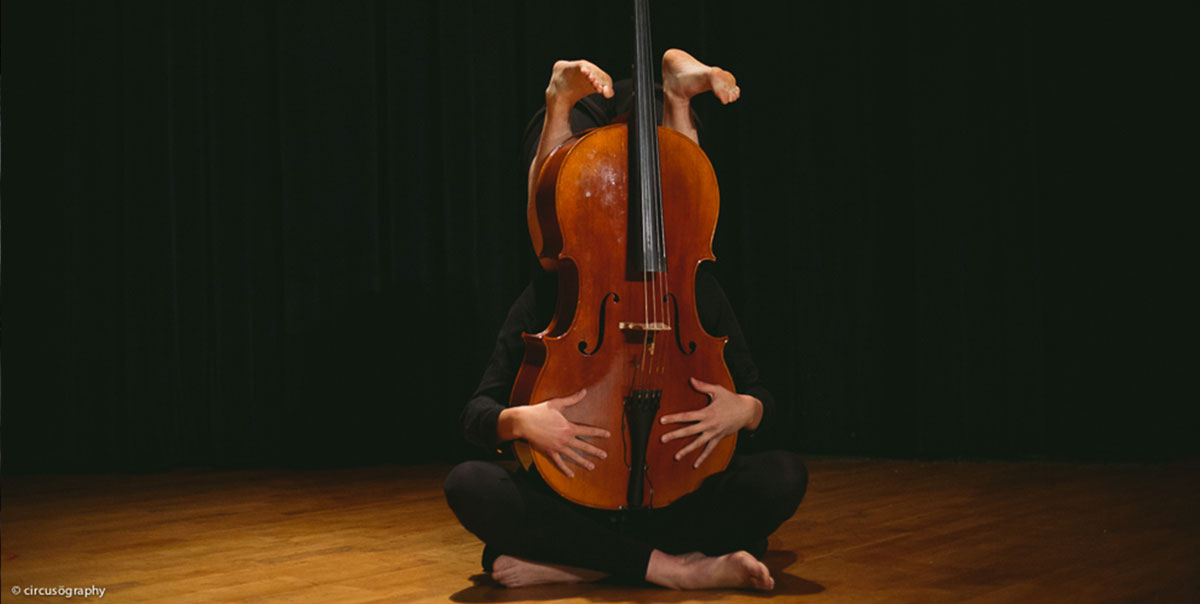 Kaléidoscope se raconte. Deux voix, deux corps et un violoncelle qui s’animent. Des tiroirs vides à remplir, des regards et des bruits qui se baladent, une culotte qui gratte, un peu de poussière comme ça… Deux silhouettes à l’étroit. Jumel, c’est le fil tendu entre le cirque et la musique. Musique : compositions & improvisations. La voix et le corps sont des instruments intuitifs. La voix nous sert autant qu’elle nous dévoile. Elle nous permet de traduire nos états intérieurs, souligne nos contradictions, nos euphories et notre personnalité toute entière. Elle résonne dans la matière du corps qui reçoit toutes les vibrations extérieures et se connecte à l’environnement. Toujours en mouvement, il peut libérer son souffle sur lequel viendra se déposer le son. Jumel s’engage et propose. A travers l’image on se reconnait dans l’autre. Dans notre travail artistique, elle est très présente. Nous aimons jouer à nous dédoubler en Jumel, à nous décupler en Kaléidoscope, à nous réunir en une seule bête, une bête munie de 8 membres inégaux… Et tout cela avant de s’y mettre à plusieurs pour tout reprendre dans le désordre !
Kaléidoscope se raconte. Deux voix, deux corps et un violoncelle qui s’animent. Des tiroirs vides à remplir, des regards et des bruits qui se baladent, une culotte qui gratte, un peu de poussière comme ça… Deux silhouettes à l’étroit. Jumel, c’est le fil tendu entre le cirque et la musique. Musique : compositions & improvisations. La voix et le corps sont des instruments intuitifs. La voix nous sert autant qu’elle nous dévoile. Elle nous permet de traduire nos états intérieurs, souligne nos contradictions, nos euphories et notre personnalité toute entière. Elle résonne dans la matière du corps qui reçoit toutes les vibrations extérieures et se connecte à l’environnement. Toujours en mouvement, il peut libérer son souffle sur lequel viendra se déposer le son. Jumel s’engage et propose. A travers l’image on se reconnait dans l’autre. Dans notre travail artistique, elle est très présente. Nous aimons jouer à nous dédoubler en Jumel, à nous décupler en Kaléidoscope, à nous réunir en une seule bête, une bête munie de 8 membres inégaux… Et tout cela avant de s’y mettre à plusieurs pour tout reprendre dans le désordre !
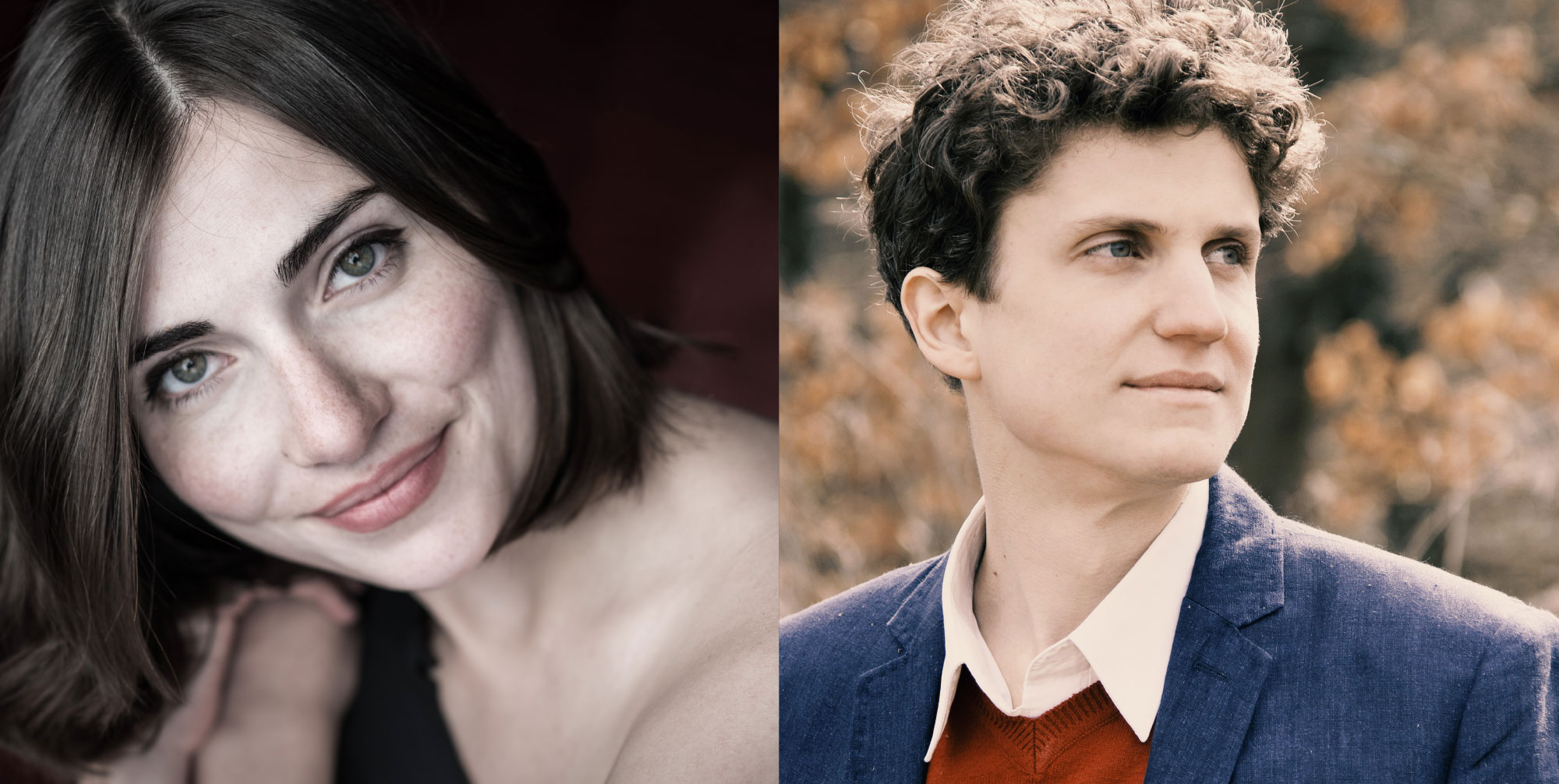
20 h 30 Salle de musique / avenue Léopold-Robert 27, La Chaux-de-Fonds
Diana Tishchenko, violon Zoltán Fejérvári, piano
Ravel Sonate Enescu Sonate n° 3 « dans le caractère populaire roumain » op.25 Ysaÿe Sonate pour violon seul n°3 « Ballade » op. 27 n°3 Prokofiev Sonate nº 1 op. 80 Actualité discographique chez Erato-Warner Imaginez la scène, Ravel heurte à la porte d’Enescu occupé à donner une leçon de violon au jeune Menuhin, 12 ans. Ravel souhaite entendre sa sonate dans la réalité. Enescu s’exécute avec plaisir et, le compositeur au piano, déchiffre l’œuvre à vue. Arrivé à la fin Enescu propose de la jouer une seconde fois. Il laisse la partition et interprète l’œuvre par cœur ! Qui dit mieux ?
« Il faut toujours garder à l’esprit l’idée que la sensibilité et l’émotion constituent le contenu véritable d’une œuvre d’art… La découverte inattendue et l’étonnement sont une partie essentielle de la beauté. »
Maurice Ravel
La fameuse sonate en sol majeur de Ravel, est la dernière œuvre de musique de chambre du compositeur. Élaborée entre 1922 et 1927, elle est dédiée à la violoniste Hélène Jourdan-Morhange, et fut créée par Ravel en personne au piano, avec Georges Enesco au violon, le 30 mai 1927. On y retrouve l’influence des grands maîtres, mais également celle du jazz et du blues si cher à Georges Gershwin, avec qui Ravel fréquenta les night-clubs enfumés d’Harlem — véritable berceau du jazz à New-York. Il est intéressant de noter que Ravel influencera le langage harmonique du pianiste américain de jazz Bill Evans, considéré comme l’un des plus grands de sa génération. Herbie Hancock autre pianiste émérite de jazz, interprétera le blues de la sonate en sol majeur lors de concerts. – La Sonate « dans le caractère populaire roumain », pour piano et violon, en la mineur op. 25, est la dernière des trois sonates pour ce duo instrumental de Georges Enesco, composée en 1926. Il s’agit d’un des chefs-d’œuvre emblématiques du musicien, à mettre au même niveau que les sonates pour violon et piano de Béla Bartók, qu’elle surclasse d’ailleurs en lyrisme comme en naturel. Ses deux premières sonates étaient des compositions de jeunesse écrites en 1897 et 1899, soit plus de vingt-cinq ans avant sa troisième. Celle-ci est dédiée à Franz Kneisel, musicien né à Bucarest, flûtiste, clarinettiste, trompettiste et violoniste ! Comme l’indique son titre, bien que fortement inspirée du folklore roumain, cette sonate n’en est nullement une transcription mais une réinvention de l’intérieur. La démarche du musicien est donc différente de celle de l’écriture de ses Rhapsodies roumaines, qui étaient aussi de relative jeunesse. Enesco emploie plusieurs caractéristiques « locales » dans sa partition : gamme chromatique, hétérophonie (léger décalage temporel des voix sans qu’on puisse réellement parler de canon), l’emploi privilégié de certains intervalles, l’utilisation de quarts de tons, etc. Il insiste sur le choix du terme « caractère » plutôt que « style » dans le titre de la sonate, soulignant par là son authenticité. La partition est extrêmement riche d’annotations pour le jeu du violoniste (coups d’archet, vibrato…), ce qui a fait affirmer à au grand violoniste Yehudi Menuhin que « jouer la partition, c’est interpréter l’œuvre » ; l’ensemble laisse cependant une impression d’improvisation tout à fait à la manière « tzigane » (que l’on retrouve aussi dans le Caprice roumain pour violon et orchestre du même compositeur), sous-tendue par une écriture complexe. – Les six Sonates pour violon solo op. 27 d’Eugène Ysaÿe, sont écrites en Juillet 1923. Chaque sonate a été consacrée à l’un des violonistes contemporains d’Ysaÿe : Joseph Szigeti (n°1), Jacques Thibaud (n°2), George Enescu (n°3), Fritz Kreisler (n°4), Mathieu Crickboom (n°5), et Manuel Quiroga (n°6). C’est après avoir entendu Joseph Szigeti jouer la sonate de J.S. Bach pour violon seul en sol mineur que Ysaye a été inspiré pour composer son œuvre pour violon seul, qui concentre l’évolution des techniques et des expressions musicales de son temps. Comme Ysaÿe a affirmé : «J’ai joué tout, de Bach à Debussy, l’art véritable doit être international». Dans cette série de sonates, il a utilisé des caractéristiques importantes de la musique du début du 20e siècle, comme les gammes en tons entiers, les dissonances et les quarts de tons. Ysaÿe emploie également la virtuosité de l’archet et la technique extrêmement sophistiquée de la main gauche, car il pensait que « à présent la maîtrise de violon, l’expression et les techniques sont indispensables si la volonté est de s’exprimer sans retenue ». Ainsi, cet ensemble de sonates est d’une exigence technique extrême pour les interprètes. Pourtant, Ysaye avertit les violonistes qu’ils ne doivent jamais oublier de chanter au lieu de devenir préoccupé par les éléments techniques car un vrai maître du violon « doit être un violoniste, un penseur, un poète, un être humain, il faut avoir connu l’espoir, l’amour, la passion et le désespoir, toute la gamme des émotions pour pouvoir s’exprimer à travers son jeu. » – Dans les années 1930, Prokofiev, qui souffrait d’un profond mal du pays, fut courtisé pour rentrer en Russie (devenue l’URSS de Staline) : on lui promit officiellement qu’il jouirait de privilèges, comme le fait d’être autorisé à effectuer régulièrement des tournées à l’Ouest, mais aussi qu’il jouerait un rôle majeur dans la reconstruction de la musique russe, ravagée par la révolution culturelle à la fin des années 1920. Il s’installera finalement à Moscou en 1936, avec sa femme et leurs deux jeunes fils. Moins d’un an plus tard, Staline déclencha sa « Grande Terreur », avec à la clef plusieurs millions d’arrestations par le NKVD (la police secrète), l’une des plus célèbres ayant été celle de Marshal Mikhaíl Tukhachevski, le mécène de Chostakovitch. Plusieurs collègues de Prokofiev furent également raflés. Le 20 avril 1937, Vladimir Mutnykh, directeur général du Bolchoï et commanditaire de Roméo et Juliette, fut arrêté. Adrian Piotrovski, co-librettiste du même ballet, suivit le 10 juillet 1937. Nataliya Sats, qui avait commandé Pierre et le loup et en avait assuré la narration avec succès, fut arrêtée le 21 août. Nikolaï Zhilyayev, compositeur, érudit et indéfectible défenseur de l’œuvre de Prokofiev, fut arrêté le 3 novembre. Hormis Nataliya Sats (qui, passé quelque temps dans un camp de travail, fut relâchée en 1942, même si elle ne fut autorisée à rentrer à Moscou qu’en 1958, cinq ans après la mort de Prokofiev), on ne les revit jamais : on sait aujourd’hui qu’ils furent tous fusillés quelques mois seulement après leur arrestation. Ce fut dans ce contexte extrêmement troublé que Prokofiev aborda sa Sonate pour violon en fa mineur op. 80, en 1938. Fait révélateur—et contrairement à Roméo et Juliette et au Concerto pour violon nº 2—, cette sonate ne présente aucun thème antérieur au retour de Prokofiev en Union soviétique : on sent qu’il tira plutôt son inspiration des très sombres puits de peur, de désespoir et de deuil qui furent son lot et celui de ses contemporains sous la Grande Terreur stalinienne. Cherchant peut-être à prendre ses distances par rapport au traumatisme symbolisé par la noirceur exceptionnelle de cette Sonate, il fit originellement le choix d’un premier mouvement respectant une stricte alternance métrique (3/4 et 4/4). Une fois cette version du premier mouvement achevée et le deuxième mouvement en grande partie rédigé, Prokofiev mit de côté sa Sonate pour écrire la musique d’Alexandre Nevski, le film d’Eisenstein. Il attendit 1943 pour s’y remettre—la Seconde guerre mondiale, mais aussi d’autres projets l’avaient de nouveau interrompu—, avouant alors à son ami Nikolaï Miaskovski qu’il la trouvait « difficile »; et il la délaissa derechef pour composer sa Symphonie nº 5. Avant de la reprendre pour de bon, il acheva sa Sonate pour violon nº 2 et ré majeur (1944). Travailler à cette seconde sonate, qui est pour l’essentiel une transcription de sa Sonate pour flûte op. 94 (composée en 1943) entreprise avec l’aide de David Oïstrakh, semble l’avoir incité à terminer sa Sonate en fa mineur. Oïstrakh s’était lié d’amitié avec Prokofiev au milieu des années 1930, alors qu’il vivait dans le même immeuble que lui, rue Chkalov, et partageait sa passion des échecs. Selon Sviatoslav, le fils aîné de Prokofiev, Oïstrakh vint chez eux pour jouer à titre d’essai des sections de la Sonate en fa mineur. Ce devait être à la fin des années 1930 car, le 15 mars 1941, Prokofiev quitta sa famille, et donc l’appartement, pour aller vivre avec Mira Mendelson, une jeune littératrice. Si Sviatoslav, âgé de dix-sept ans au départ de son père, ne se trompe pas, si c’est bien la Sonate pour violon et non le Concerto pour violon nº1 (exécuté par Oïstrakh sous la baguette de Prokofiev le 22 octobre 1939) que les deux hommes jouèrent, cela signifie que Oïstrakh fut extrêmement impliqué dans cette Sonate dès le début de sa conception et non—comme on le suppose généralement—à partir de 1943. Pourtant, et même s’il la dédia finalement à David Oïstrakh, Prokofiev composa manifestement cette sonate pour apaiser un traumatisme secret. Oïstrakh se rappela que, lors des répétitions, Prokofiev lui dit que les impétueux passages en gammes des premier et dernier mouvements devaient sonner « comme le vent dans un cimetière ». Et Oïstrakh d’ajouter : « Après une telle remarque, tout l’esprit de la sonate revêtit pour nous une importance plus profonde. » Car, chose apparemment tout sauf anodine, Prokofiev, lorsqu’il reprit sa sonate en 1943, inclut dans ses révisions du premier mouvement ces passages en gammes impétueux, marqués freddo et jusqu’alors absents de l’œuvre. En parlant de ces gammes, Prokofiev semble également avoir voulu faire référence à la célèbre manière dont Anton Rubinstein dépeignit le finale de la Sonate pour piano en si bémol mineur de Chopin : « un vent du soir qui souffle sur les tombes d’un cimetière ». Cependant, et contrairement au chromatisme angoissé de Chopin, les gammes impétueuses de Prokofiev paraissent sereines, comme si elles formaient un havre loin du style tourmenté, parfois brutal, du reste de la sonate. Prokofiev ignorait probablement le sort de ses collègues arrêtés en 1937 (et les noms que nous avons cités sont seulement ceux dont nous avons connaissance), mais la Sonate en fa mineur sur laquelle il peina si longtemps fut certainement voulue comme un mémorial voilé mais aimant à tous ceux qui, à l’instar de plusieurs de ses confrères, avaient été effacés de l’histoire stalinienne officielle. Vers la dernière année de sa vie, il dressa une liste annotée de ses compositions: en inscrivant sa Sonate en fa mineur, il développa d’ailleurs la description de Rubinstein et évoqua «un cimetière abandonné», signe qu’il songeait à des morts bien antérieurs aux évidentes victimes de la guerre—il acheva cette œuvre à l’été de 1946.
Mardi
7 JUL 2020, 19:45 pm
Concert originally scheduled for May 9, 2020 7:45 pm – 9:45 pm Salle de musique / avenue Léopold-Robert 27, La Chaux-de-Fonds
Arod Quartet
Jordan Victoria, violin Alexandre Vu, violin Tanguy Parisot, viola Samy Rachid, cello
“Go away – Ah go away from me cruel skeleton I’m still young, let me, not touch me, dear death. Give me your hand, you beautiful and tender I come as a friend not to punish you. Be brave, I am not cruel. You will sleep at peace in my arms.
Schubert String Quartet No. 4 in C major Schubert String Quartet No. 12 in C minor Schubert Der Tod und das Mädchen (The Maiden and Death) String Quartet No. 14 in D mineur D 810 Wanting to understand Schubert, his so particular lyricism, a mixture of candor and dark visions, is to begin by immersing oneself in his matrix universe: the romantic Lied. Schubert will give this advice: “To be listened to in winter, but in my lieder, spring with all its flowers is already present”. This duality between ashes and embers permeates the poetic world in which Schubert lived his real life. Through popular texts, but above all through the poems of little poets (for apart from Heine, and so little Goethe, the great poets have always rendered musicians powerless), Schubert lived vicariously through lives and loves adrift: pale moon, snow and winter, brook-tomb, pale forests, young girls who betray, sleep and death. Schubert’s inspiration is a wandering in these words that touched him deeper than tears, so the theme of consoling death was constant in his mind. Death rained down everywhere in his life, and in between mourning and his stillborn works, Schubert had made himself a gentle and resigned philosophy about the world. All the more so as the era, itself melodramatic and morbid, was very much focused on the presence of death and its taming through consolation. The String Quartet in D minor was completed in March 1824, at the same time as the String Quartet No. 13 in A minor Rosamunde and the Octet. These quartets were brought together after a great period of doubt and sterility. Pianist, but also violist Schubert liked to make music together. Chamber music was to be his home. Schubert made quartets very early, at least five in 1813. Then two more in 1814 and in the years 1815-1816. But for more than eight years, from 1816 to 1824, he did not compose any quartets. He was elsewhere, immersed in the abundance of lieder that flowed from him without restraint. Failed operatic projects also took up his time. The return to the noble and austere form that is the string quartet came about by the reminder of the fragility of existence that struck him in 1824. Hardly recovered from a very serious venereal disease, as if by an inner promise he returned to the form of the quartet, but also to the writing of dances and variations. As if life was returning. He also wanted to move towards “higher” forms, the symphony: “I have composed two quartets… and I still want to write, because only in this way can I find my way to the great symphony”. But these almost twin quartets, Rosamunde and The Maiden and Death, are still singing, surpassing singing. Quartet No. 14 was not performed privately until two years later, in 1826, and could never be published during Schubert’s lifetime. The overall key of this quartet is based on the key of the Lied “der Tod und das Mädchen” composed in February 1817, whose text by Matthias Claudius is given below: Go away – Ah go away from me cruel skeleton I am still young, let me, not touch myself, dear death. Give me your hand, you beautiful and tender I come as a friend not to punish you. Be brave, I am not cruel You will sleep calmly in my arms.
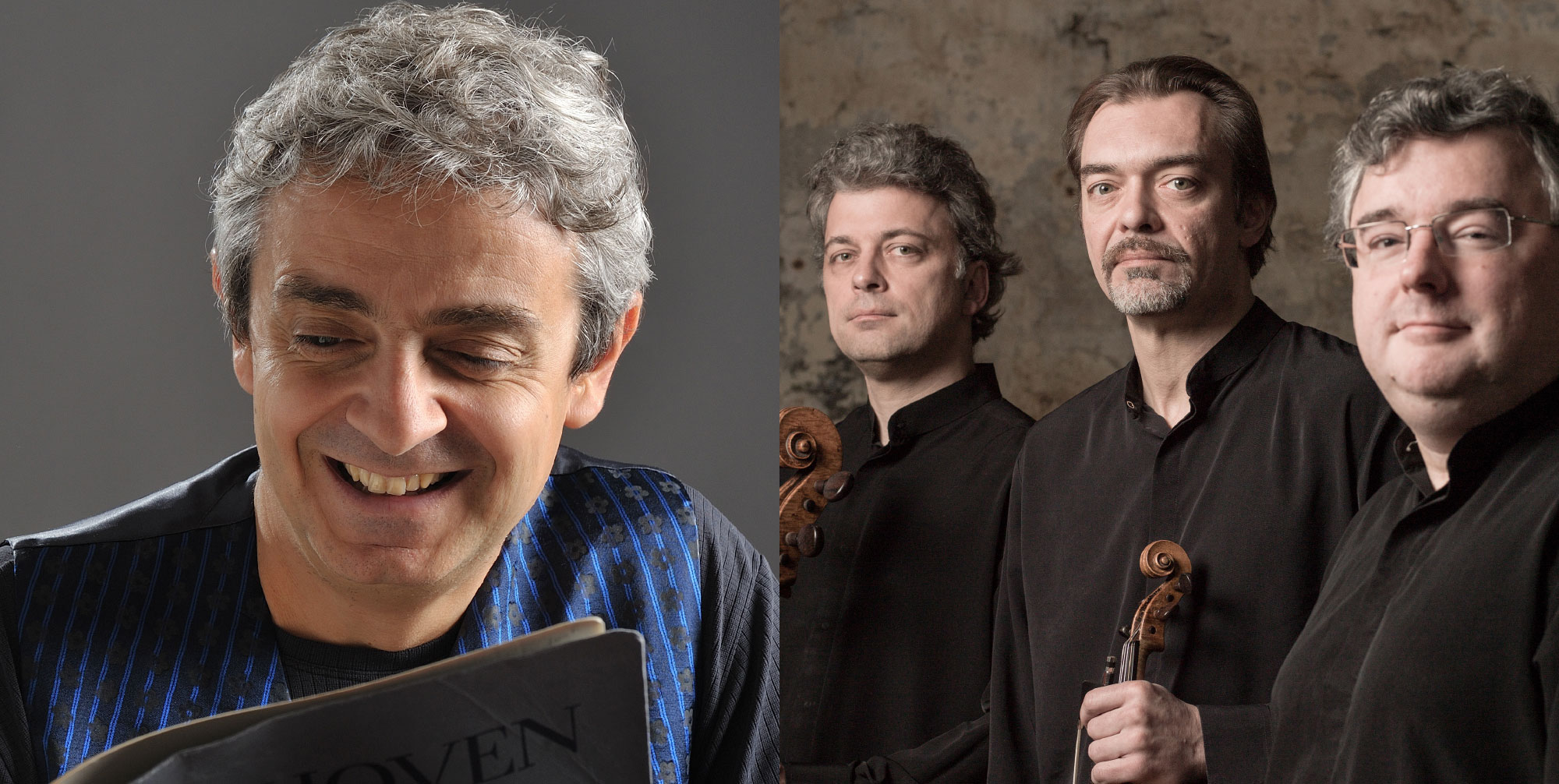
Dimanche
16 FÉV 2020
17 h 00 – 19 h 00 Salle de musique / avenue Léopold-Robert 27, La Chaux-de-Fond
Trio Wanderer & Pascal Moraguès, clarinette
Vincent Coq, piano
Jean-Marc Phillips-Varjabédian, violon
Raphaël Pidoux, violoncelle
Pascal Moraguès, clarinette
Beethoven
Trio op. 11 pour clarinette, violoncelle et piano
Beethoven
« Trio des Esprits » pour violon, violoncelle et piano
Bartok
Contrastes, pour clarinette, violon et piano
Hindemith
Quatuor pour clarinette, violon, violoncelle et piano
Il y a 250 ans, en décembre 1770, naissait Ludwig van Beethoven. Sa musique allait toucher le coeur des humains. La postérité lui a donné une dimension universelle.
La première partie du concert rend hommage à la grandeur du musicien, de l’homme, non pas au sens égocentrique du terme, mais dans ce qu’il peut contenir d’universalité, d’humanité, de cœur, d’esprit et de paix.
Samedi
15 FÉV 2020
14h30 à 20h (accueil à 14h20) Salle de musique / avenue Léopold-Robert 27, La Chaux-de-Fonds
Cours public d’interprétation par Pascal Moraguès aux élèves de clarinettes du Conservatoire de musique neuchâtelois-CMNE
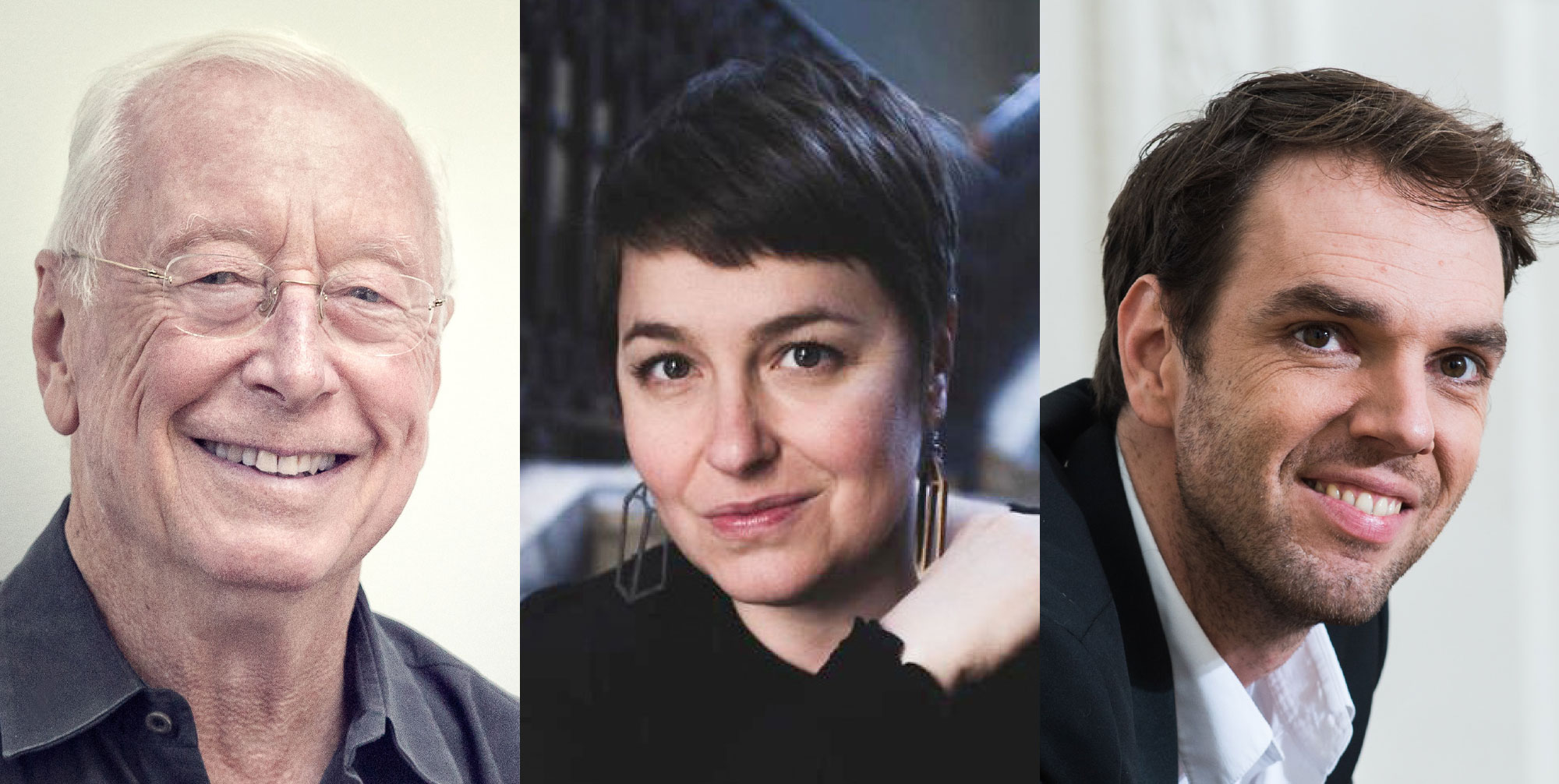
jeudi
30 JAN 2020
19 h 30 – 21 h 30 Salle de musique / avenue Léopold-Robert 27, La Chaux-de-Fonds
Les Arts Florissants William Christie, direction musicale et clavecin
Emmanuelle de Negri, soprano Thomas Dolié, baryton
Instrumentistes des Arts Florissants :
Violons : Emmanuel Resche, Théotime Langlois de Swarte
Viole de gambe : Juliette Guignard
Flûte traversière : Serge Saitta
Théorbe : Clément Latour
Emmanuel Resche-Caserta joue sur un violon de Francesco Ruggeri prêté par la Fondation Jumpstart Jr (Amsterdam)
Les Arts Florissants redonnent vie à l’une des plus brillants salons du Grand Siècle, un Salon constitué d’artistes et d’intellectuels rassemblés par l’une des femmes les plus puissante de son temps, la Duchesse du Maine dans son Château de Sceaux. Voltaire, D’Alembert, Montesquieu ou Marivaux étaient tous des visiteurs réguliers, ainsi que des compositeurs bien connus de l’époque, comme Clérambault, Bernier et Mouret ; tous ont écrit de nombreuses œuvres qui lui étaient dédiées ou qui s’inspiraient d’elle. Et comme la Duchesse était insomniaque, les soirées étaient longues…
« Le Salon de la Duchesse »
sélection de Cantates séculaires
Nicolas Bernier (1664-1734)
Duo extrait de la Cantate « Europe et Jupiter »
(Cantates, Livre IV, 1739)
Jean-Joseph Mouret (1682-1738)
Premier concert, extraits :
Ouverture – Venissienne – Air – Rondeau – Sarabande – Tambourins I et II
(Concert de chambre pour les violons, flûtes, et hautbois (…), s.d.)
Louis-Nicolas Clérambault (1676-1749)
L’Amour piqué par une abeille
(Cantates, Livre I, 1710)
Jean-Joseph Mouret
Prens la pinte Claudeine
Du Dieu du vin quand tu chantes la gloire
Buvons Enyvrons nous tous deux
(III° Livre d’airs sérieux et à boire, 1727)
Nicolas Bernier
L’Amour vainqueur
(Cantates, Livre VI, s.d.)
Jean-Joseph Mouret
Premier concert, extraits :
Chaconne (coupure de mesure 89 à mesure. 124)
(Concert de chambre pour les violons, flûtes, et hautbois (…), s.d.)
Nicolas Bernier
Diane et Endimion
(
Cantates, Livre II, s.d.)
18 h 15 – 18 h 45 : avant-concert Conservatoire de musique neuchâtelois, Salle Faller, La Chaux-de-Fonds
Elèves du Collège musical de la Ville de La Chaux-de-Fonds
Entrée libre
Jana Willi et Malika Naula, flûtes à bec, classe de Danièle Golan.
Avec la collaboration de Miriam Lubin clavecin et Marion Bélisle violoncelle
Marin Marais (1656-1728) de la Suite en mi mineur pour pour deux dessus et continuo : Prélude lentement – Fantaisie – Gavotte – Rondeau – Sarabande en rondeau – Menuet – Caprice lentement – Passacaille
Jacques Martin Hotteterre le Romain (1674-1763) Sonate en trio pour flûtes à bec et basse continue op 3 n°4 en sol mineur : Gravement – Fugue gay – Grave – Gigue
Sources :
Concert 1 – Les Arts Florissant
Concert 2 – Beethoven, opus 11 et 70 : notes rédigées par Richard Wigmore © 2004 / Bartok : Clédesol, cldesol.blogspot.com / Hindemith : francemusique.fr
Concert 3 – Céline Hänni, Centre de culture ABC
Concert 4– Schubert : espritsnomades.net / Webern : wikipedia et amazon
Concert 5 – Ravel : musicologie.org / Enesco : wikipedia / Ysaÿe : arion-music.com / Prokofiev : hypérion-records.co.uk

